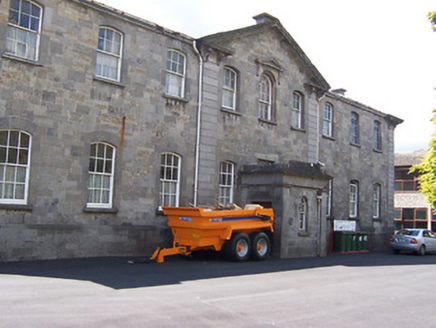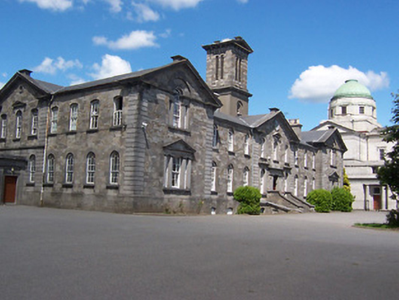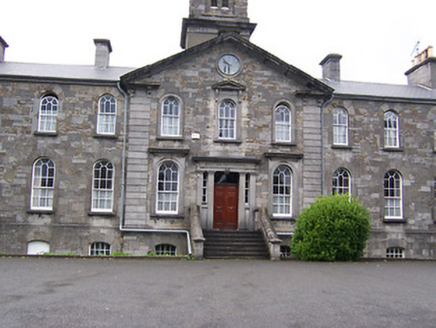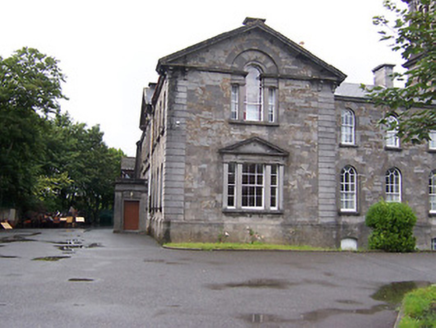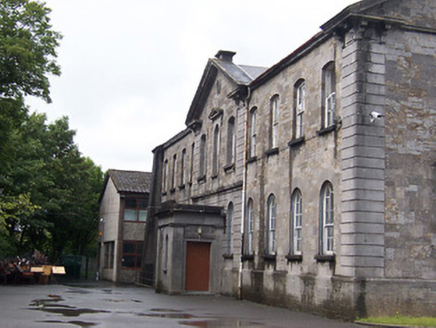Survey Data
Reg No
15310167
Rating
National
Categories of Special Interest
Architectural, Artistic, Historical, Social
Original Use
School
In Use As
School
Date
1850 - 1860
Coordinates
243368, 253178
Date Recorded
07/07/2004
Date Updated
--/--/--
Description
Detached eleven-bay two-storey over basement school on U-shaped plan, built between 1854 and 1856, having an advanced three-bay pedimented breakfront to the centre of the main façade (south), a two-stage Italianate belfry on square-plan with hipped roof over set back behind the advanced central breakfront and having single-bay gable-fronted breakfronts to either end of the main façade. Pedimented three-bay sections to the centre of the side elevations (west and east) having central single-bay flat-roofed enclosed Tuscan entrance porches. Pitched natural slate roofs with projecting eaves course, ashlar limestone chimneystacks with terracotta pots over, cast-iron rainwater goods and with overhanging bracketed eaves to pedimented sections having raised cut stone verges over. Constructed of squared snecked limestone with extensive ashlar limestone trim, including chamfered plinth to base, dressings to the openings and raised block quoins to the corners. Clockface to central pediment. Round-headed window openings to the front façade of the main body of the building having timber sliding sash windows. Round-headed windows to central breakfront with architraved surrounds and moulded cornices over the ground floor openings (flanking central doorway), architraved surrounds over first floor windows and with a cut stone pediment over the central window at first floor level supported on scrolled console brackets. Pedimented tripartite window openings with Doric pilasters to the advanced end bays at ground floor level with inset Venetian window openings over at first floor level having Doric pilasters set in a round-headed recesses/blind arches. Tripartite doorcase to the central breakfront having moulded cornice over supported on Doric pilasters, timber panelled double-doors, sidelights and a plain overlight above. Doorway reached up flight of cut stone steps flanked to either side by plinth walls with cut stone coping over. Set back from road in extensive mature grounds with modern school buildings to the rear (north) and Mullingar Cathedral (15310166) to the east. Located to the north of Mullingar town centre.
Appraisal
A highly accomplished, dignified and well-detailed mid nineteenth-century edifice, built in a composed classical idiom, which retains its early form, character and fabric. It uses a wide variety of Classical features in its pleasing symmetrical façade, including pedimented breakfronts, Venetian windows, architraved surrounds, an Italianate belfry, Tuscan porches and a fine tripartite doorcase. It is well-built using good quality materials, costing some £5000 at the time of construction, and still retains its original impressive authority. This building was built to designs by John Bourke (died 1871), a noteworthy architect of his age. It was built at the bequest of a rich local Catholic landowner/brewer James Hevey, who died in 1837 and left his lands and a considerable proportion of his estate to fund the construction of a school to ‘provide for the education of the poor children of Mullingar’. The wing to the west end was originally called ‘The Latin Wing’, where classical languages and ancient history were taught to students intending to enter the Roman Catholic Seminary at Maynooth College, and perhaps this was the inspiration behind the fine classical design adopted for this elegant building. This structure is one of the most important elements of the architectural heritage of Mullingar and has played a central role in the educational and social history of the local area since the mid nineteenth-century.
